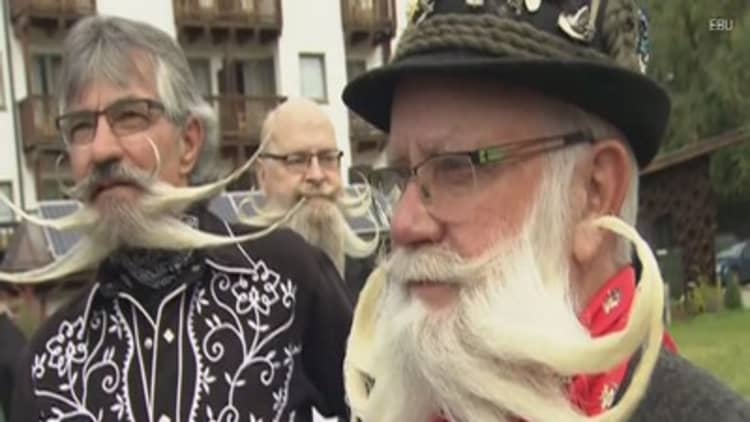Politicians sometimes wear them, and so do a few chief executives. Urban hipsters have become synonymous with them, yet rugged outdoorsmen have been sporting them for years.
Beards — having become so popular that they've even had an annual movement ("no shave November," now more or less a year-round display) named after them — are part of a growing category of the male grooming market, which sees more than $6 billion in sales annually, according to Euromonitor data.
The slow decline of clean-shaven faces has given rise to a new male archetype, one that's becoming a coveted market demographic in its own right and spurring the rise of small businesses that cater to pampering hairy faces.
The phenomenon is easy to spot on social media, with Instagram and Twitter posts exploding with hirsute hashtags like "#beardgang" and "beardgods" praising those with well-groomed beards — and mocking those without them. Surf those terms and you'll likely discover a host of self-styled 'beard models' — and thousands of ardent admirers.
"The idea of male beauty went from the all-American guy to a more natural, romantic look; hair on the body," Philip Fimmano, a style expert with Studio Edelkoort, a trend forecasting company, told CNBC in a recent interview.
Read MoreTwitter CEO Dorsey's beard goes viral
The more rugged looking male is in fact "very sensitive, and not afraid of taking care of his appearance," Fimmano said. Believe it or not, that's not a contradiction in terms, he added.
"Although beards may look unruly to those who don't have them, it actually requires a lot of grooming," Fimmano said.
Only for a 'certain demographic'
The movement to "kill the shave" has had the added effect of overshadowing razor blade sales. In a 2015 research report, Euromonitor said men's toiletries — which include new products such as beard balms, oils, shampoos and conditioners — grew by 4 percent to $3.4 billion. Meanwhile, shaving grew at half that rate, to $2.9 billion. In recent years, some analysts have also attributed stagnating razor blade sales to the rise of beards.
Some observers think the trend is already on its way out the door. Anderson La, a hair stylist at Sassoon Salon, said he wasn't sure how sustainable beards are in the long run.
"It seems to only appeal to a certain demographic," La said. "A majority of men still like and are required to keep their face clean for most mainstream professional jobs." La added that some higher-end barbershops cater to grooming bearded men, but "regular salons usually don't."
Yet evidence suggests that the demand for facial hair has increased the supply of products and businesses willing to cater to them.
Alun Withey, an academic and a self-styled beard historian (no, really), told CNBC that barbershops and beard care toiletries are among the fastest growing business segments in the U.K. and the U.S.
Withey found that barbershops and beard care products are the fastest growing businesses in the U.K. and the U.S. According to the academic, the trend is part of a historical cycle, but the current incarnation is different from its predecessors.
"In the 18th century they disappeared and around 1850 they were back with a vengeance," Withey said. "If you go back 300 to 400 years ago, trends will last for decades," such as Victorian-era beards, which Withey said lasted five decades. The current beard wave has been the longest for at least 30 years, he added.
Lumbersexuals and brand loyalty

And unlike years past, the growth of facial hair has also been accompanied by a boom in products to care for them. In a 2015 report, market analysis firm Datamonitor said start-ups geared toward beard grooming have exploded in recent years, soaring more than fivefold from eight in 2011 to 42 in 2014. The firm, which recently changed its name to Canadean, characterized the move as a shift away from the cleaner-shaven "metrosexual" look to that of a lumberjack — giving way to a ballooning "lumbersexual" movement.
Dylan Yazel is one of those capitalizing on the hairy trend. The owner of Bearded Pleasures, a beard-grooming product company, thinks that the hairy and proud moment is here to stay. After all, "beards have been around since men have been around," he told CNBC recently.
Yazel recently secured a deal to place his line of toiletries and accessories in Whole Foods stores, but said that his company focuses on the one place you wouldn't expect to find hairy men — in the barbershop. In just over a year, Bearded Pleasures has gone from an Instagram-based business to a fully established company.
"We strictly focus on barbershops because we only target people who are serious about it," said Yazel. "This is why we stay true to our brand."
Like small shale producers and technology upstarts, Yazel said that not every beard care company will be able to stand the test of time. A number of new brands are popping up on the scene as larger, more established men's cosmetics try and encroach on the hot new market.
"They're going to try to take over the market and only a few will survive," Yazel said. "It comes down to loyalty, and … fad guys will go to the bigger brands." According to the owner, his company does everything by hand, with Yazel and his team measuring Bearded Products' beard oil "bottle by bottle."
The current offerings of the male grooming market largely encourage men to shave. That said, the resurgent beard culture is acting as a catalyst for specialty products, according to Withey. That means the trend could last longer than some expect.
"I wouldn't be surprised if the rise of products for beards stay," Withey said. "I think it's established itself as a niche."



